-
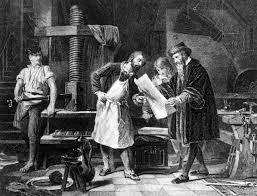 Gutenberg made the printing press in 1450.The printing press started mass production of text.The Printing Press makes copies of text or images by pressing inked plates onto paper.
Gutenberg made the printing press in 1450.The printing press started mass production of text.The Printing Press makes copies of text or images by pressing inked plates onto paper. -
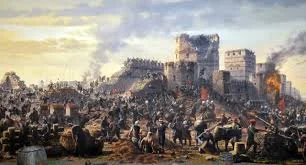 In 1453, the Ottoman Empire which was led by Sultan Mehmed II conquered Constantinople, ending the Byzantine Empire. The Byzantine capital was old and didn't have enough soldiers to defend its walls against the Ottoman army.
In 1453, the Ottoman Empire which was led by Sultan Mehmed II conquered Constantinople, ending the Byzantine Empire. The Byzantine capital was old and didn't have enough soldiers to defend its walls against the Ottoman army. -
Tudor Dynasty-English and Welsh royal family that ruled England from 1485 to 1603.It was founded by Henry VII and ended with Elizabeth I.
-
 The Alhambra Decree was an edict signed on March 31, 1492, by King Ferdinand II of Aragon and Queen Isabella I of Castile, ordering all Jews to convert to Catholicism or be expelled from Spain.
The Alhambra Decree was an edict signed on March 31, 1492, by King Ferdinand II of Aragon and Queen Isabella I of Castile, ordering all Jews to convert to Catholicism or be expelled from Spain. -
 The last Muslim ruler of the Emirate of Granada, Sultan Muhammad XII surrendered the city to the Catholic Monarchs, Ferdinand II of Aragon and Isabella I of Castile
The last Muslim ruler of the Emirate of Granada, Sultan Muhammad XII surrendered the city to the Catholic Monarchs, Ferdinand II of Aragon and Isabella I of Castile -
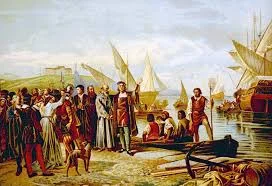 Christopher Columbus sailed from Spain in 1492, looking for a new way to get to Asia. He accidentally landed in the Americas, reaching an island in the Bahamas. He made four trips but never knew that he found a new continent.
Christopher Columbus sailed from Spain in 1492, looking for a new way to get to Asia. He accidentally landed in the Americas, reaching an island in the Bahamas. He made four trips but never knew that he found a new continent. -
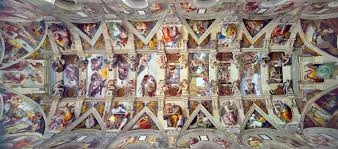 Michelangelo finished the Sistine Chapel ceiling in 1512, it took him 4 years.It shows nine scenes from the biblical Book of Genesis. Him doing this cemented his legacy and it became one of the most influential works of the High Renaissance.
Michelangelo finished the Sistine Chapel ceiling in 1512, it took him 4 years.It shows nine scenes from the biblical Book of Genesis. Him doing this cemented his legacy and it became one of the most influential works of the High Renaissance. -
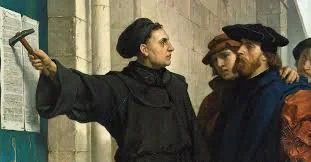 Martin Luther posted his Ninety-five Theses, a list of criticisms of the church to the door of the Castle Church in Wittenberg, Germany. This act is considered the start of the Protestant Reformation.
Martin Luther posted his Ninety-five Theses, a list of criticisms of the church to the door of the Castle Church in Wittenberg, Germany. This act is considered the start of the Protestant Reformation. -
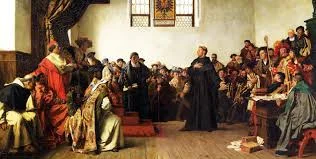 Luther refused to recant his theological writings before Holy Roman Emperor Charles V his refusal led to him being declared an outlaw but his supporters saved him from punishment.
Luther refused to recant his theological writings before Holy Roman Emperor Charles V his refusal led to him being declared an outlaw but his supporters saved him from punishment. -
 The Prince by Niccolò Machiavelli was a political guide advising rulers on how to gain, maintain, and expand power. It was written in 1513, but it was not published until 1532, after he died. The book circulated in manuscript form before publication and was controversial due to its ruthless advice.
The Prince by Niccolò Machiavelli was a political guide advising rulers on how to gain, maintain, and expand power. It was written in 1513, but it was not published until 1532, after he died. The book circulated in manuscript form before publication and was controversial due to its ruthless advice. -
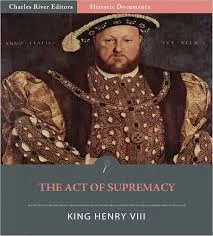 A 1534 law passed by the English Parliament that made King Henry VIII the "Supreme Head on Earth of the Church of England". By splitting the Church of England from the pope and the Roman Catholic Church, this effectively created the Anglican Church.
A 1534 law passed by the English Parliament that made King Henry VIII the "Supreme Head on Earth of the Church of England". By splitting the Church of England from the pope and the Roman Catholic Church, this effectively created the Anglican Church. -
 Nicolaus Copernicus, a Polish astronomer, published On the Revolutions of the Heavenly Spheres (De revolutionibus orbium coelestium) in 1543. He got a copy of the finished work on his deathbed.
Nicolaus Copernicus, a Polish astronomer, published On the Revolutions of the Heavenly Spheres (De revolutionibus orbium coelestium) in 1543. He got a copy of the finished work on his deathbed.
His work had the heliocentric model of the universe, which had the Sun rather than the Earth at the center. -
The Roman Catholic Church's official response to the Protestant Reformation. It took place over 18 years, from 1545 to 1563, with several long breaks.
-
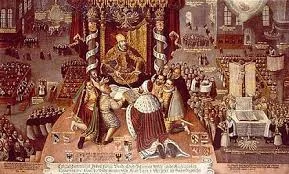 A 1555 treaty that ended the religious conflict between Catholics and Lutherans within the Holy Roman Empire by establishing the principle of cuius regio, eius religio ("whose realm, his religion").
A 1555 treaty that ended the religious conflict between Catholics and Lutherans within the Holy Roman Empire by establishing the principle of cuius regio, eius religio ("whose realm, his religion"). -
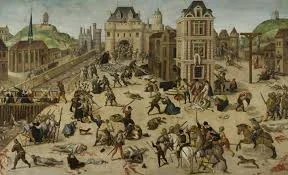 An attack of Catholic mob violence against French Protestants in 1572. Beginning in Paris.It spread to towns across France leaving thousands dead and marking a major turning point in the French Wars of Religion.
An attack of Catholic mob violence against French Protestants in 1572. Beginning in Paris.It spread to towns across France leaving thousands dead and marking a major turning point in the French Wars of Religion. -
A civil war in France which was part of the French Wars of Religion. The conflict had three powerful Henrys going against each other for control of the throne and the future of France: Henry III, the king of France; Henry I, Duke of Guise, the leader of the militant Catholic League; and Henry of Navarre, the Protestant heir to the throne.
-
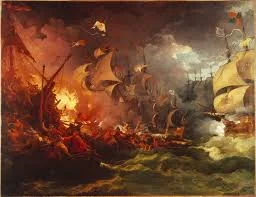 A climactic event in the rivalry between King Philip II of Spain and Queen Elizabeth I of England. Their conflict led to the Spanish invasion attempt in 1588. The defeat changed the course of European history, lowering Spanish dominance and boosting England's position as a power.
A climactic event in the rivalry between King Philip II of Spain and Queen Elizabeth I of England. Their conflict led to the Spanish invasion attempt in 1588. The defeat changed the course of European history, lowering Spanish dominance and boosting England's position as a power. -
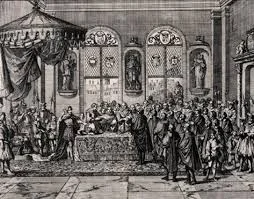 A decree issued in 1598 by King Henry IV of France that granted civil and religious liberty to the Huguenots. It was created to end the bloody Wars of Religion between Catholics and Protestants that had torn the country apart for nearly four decades.
A decree issued in 1598 by King Henry IV of France that granted civil and religious liberty to the Huguenots. It was created to end the bloody Wars of Religion between Catholics and Protestants that had torn the country apart for nearly four decades.